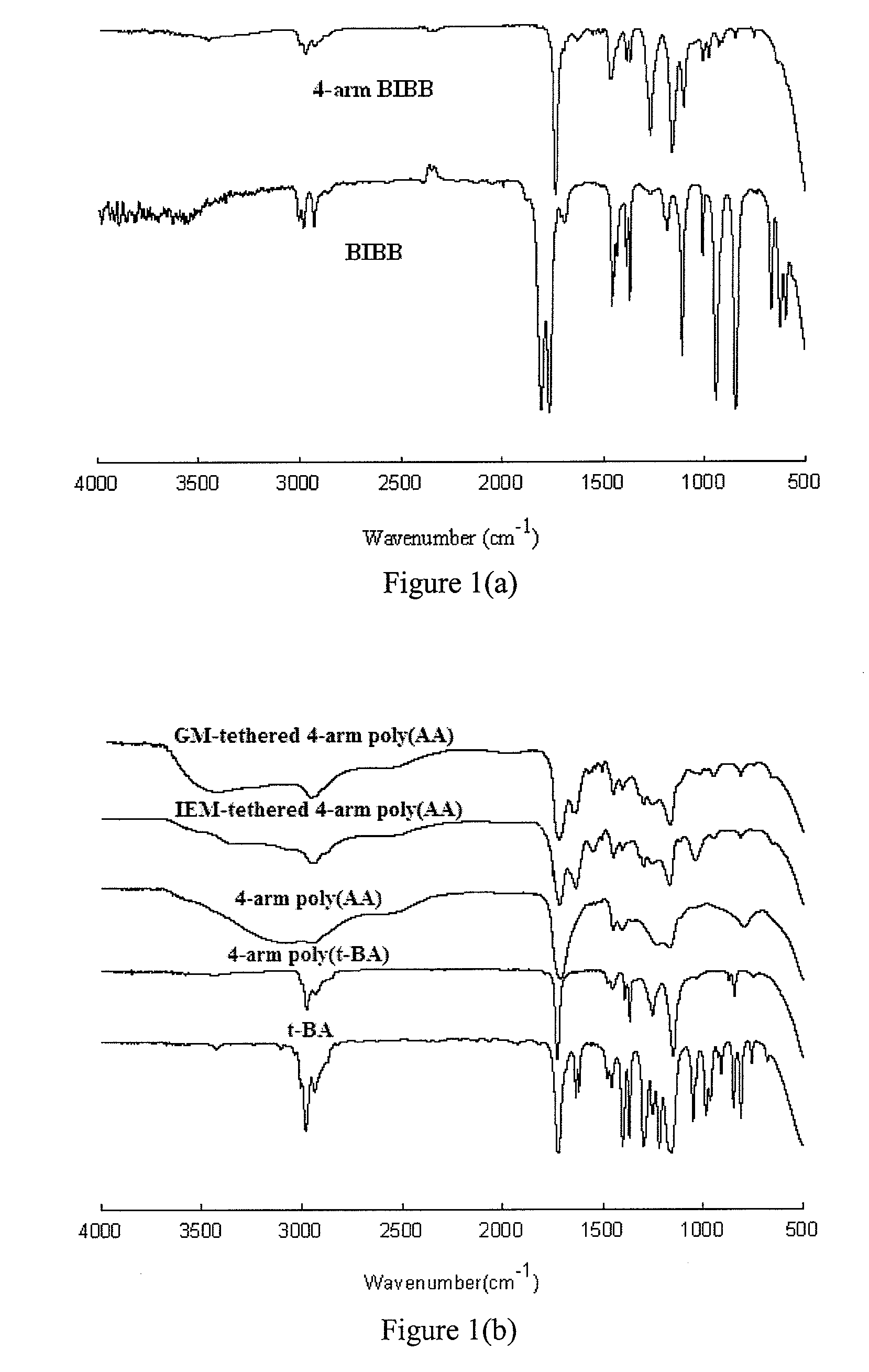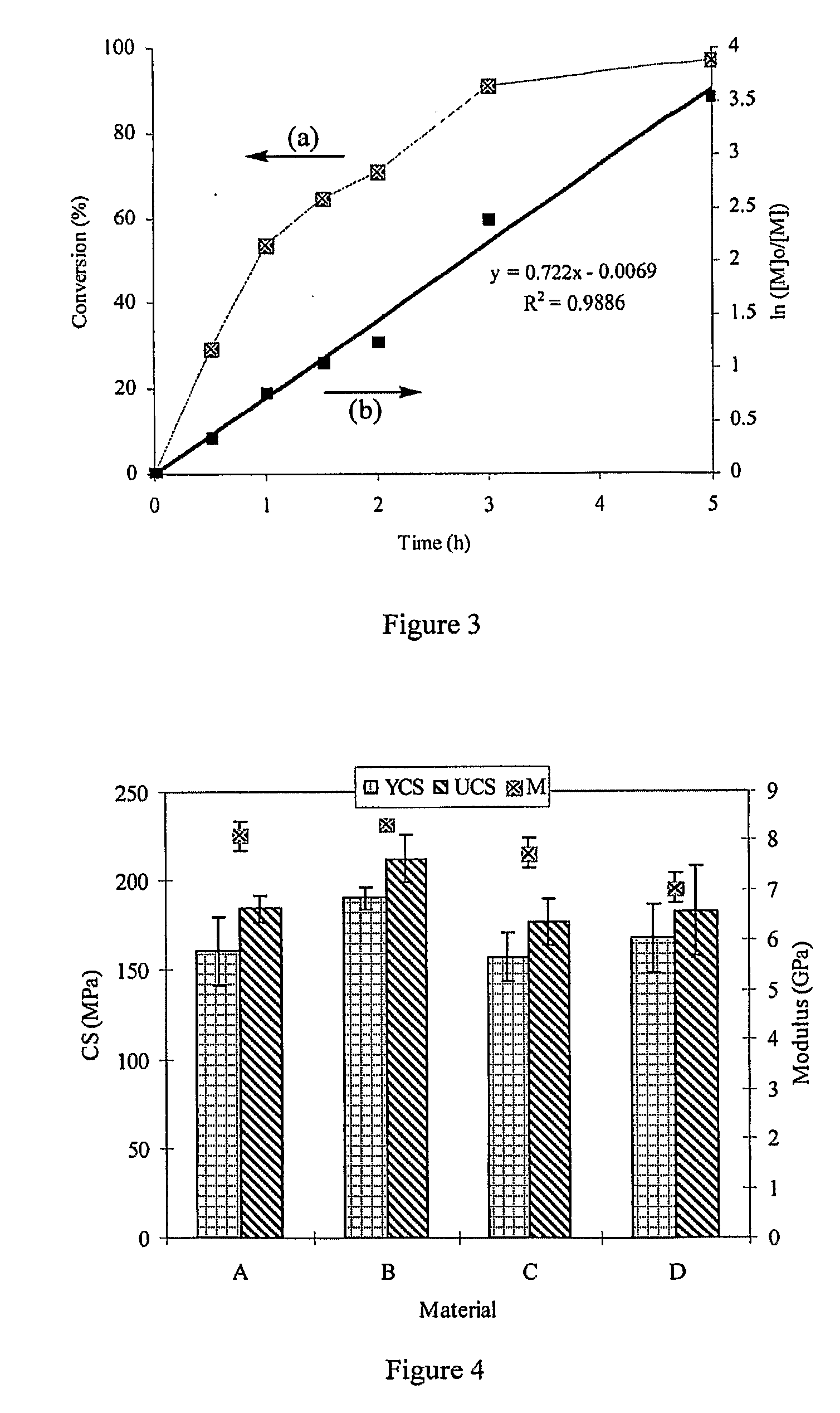Polyfunctional compounds and uses as implant materials
a polymer and functional technology, applied in the field of polymers, can solve the problems of insufficient tensile and flexural strength or brittleness of conventional gics for some applications, and achieve the effects of improving mechanical strength properties, low solution or melt viscosity, and improving workability characteristics
- Summary
- Abstract
- Description
- Claims
- Application Information
AI Technical Summary
Benefits of technology
Problems solved by technology
Method used
Image
Examples
examples
[0047]The following abbreviations are used herein: Trimethylolpropane (TMP), Pentaerythritol (PE), triethylamine (TEA), Dipentaerythritol (DPA), 2-bromoisobutyryl bromide (BIBB), Cuprous bromide (CuBr), N,N,N′,N′,N″-pentamethyldiethylenetriamine (PMDETA), dl-camphoroquinone (CQ), diphenyliodonium chloride (DC), 2,2′-azobisisobutyronitrile (AIBN), dibutyltin dlaurate (DBTL), triphenylstibine (TPS), pyridine (C6H5N), tert-butyl acrylate (t-BA), methacryloyl chloride, beta-alanine (BA), 2-hydroxyethyl methacrylate (HEMA), 2-isocyanatoethyl methacrylate (IEM), glycidyl methacrylate (GM), anhydrous magnesium sulfate (MgSO4), sodium hydroxide (NaOH), hydrochloric acid (HCl, 37%), diethyl ether (Et2O), tetrahydrofuran (THF), methanol (MeOH), deuterated methyl sulfoxide (DMSO-d6), and ethyl acetate (EtOAc). Each reagent was used as received from commercial suppliers. GC FUJI II and GC FUJI II LC glass powders were supplied by GC America Inc (Alsip, Ill.).
Example
[0048]Synthesis of the 4-arm ...
example
[0081]Synthesis of the GM-tethered 4-arm PAA. The reaction between GM and carboxylic acid on PAA took about fourteen hours to complete. Disappearance of the epoxy group on GM at 761 cm−1 (FT-IR) confirmed the completion of the tethering reaction. The completion of the tethering of GM was also confirmed by the fact that the yield was greater than 95%.
Method Example
[0082]Significance of tethering of GM onto the 4-arm PAA. It is believed that the main difference between RMGICs and CGICs is their liquid composition as described by A. D. Wilson, “Resin-modified glass-ionomer cement” Int. J. Prosthodont. 3 (1990) 425-429. The liquid in RMGICs is composed of HEMA, photo-initiators, water, and a poly(alkenoic acid) having pendent in situ polymerizable methacrylate on its backbone or a mixture of poly(alkenoic acid) and methacrylate-containing monomer / oligomer. The liquid in CGICs consists of only hydrophilic poly(alkenoic acid) and water. Due to introduction of hydrophobic methacrylate func...
PUM
| Property | Measurement | Unit |
|---|---|---|
| temperature | aaaaa | aaaaa |
| diameter | aaaaa | aaaaa |
| diameter | aaaaa | aaaaa |
Abstract
Description
Claims
Application Information
 Login to View More
Login to View More - R&D
- Intellectual Property
- Life Sciences
- Materials
- Tech Scout
- Unparalleled Data Quality
- Higher Quality Content
- 60% Fewer Hallucinations
Browse by: Latest US Patents, China's latest patents, Technical Efficacy Thesaurus, Application Domain, Technology Topic, Popular Technical Reports.
© 2025 PatSnap. All rights reserved.Legal|Privacy policy|Modern Slavery Act Transparency Statement|Sitemap|About US| Contact US: help@patsnap.com



